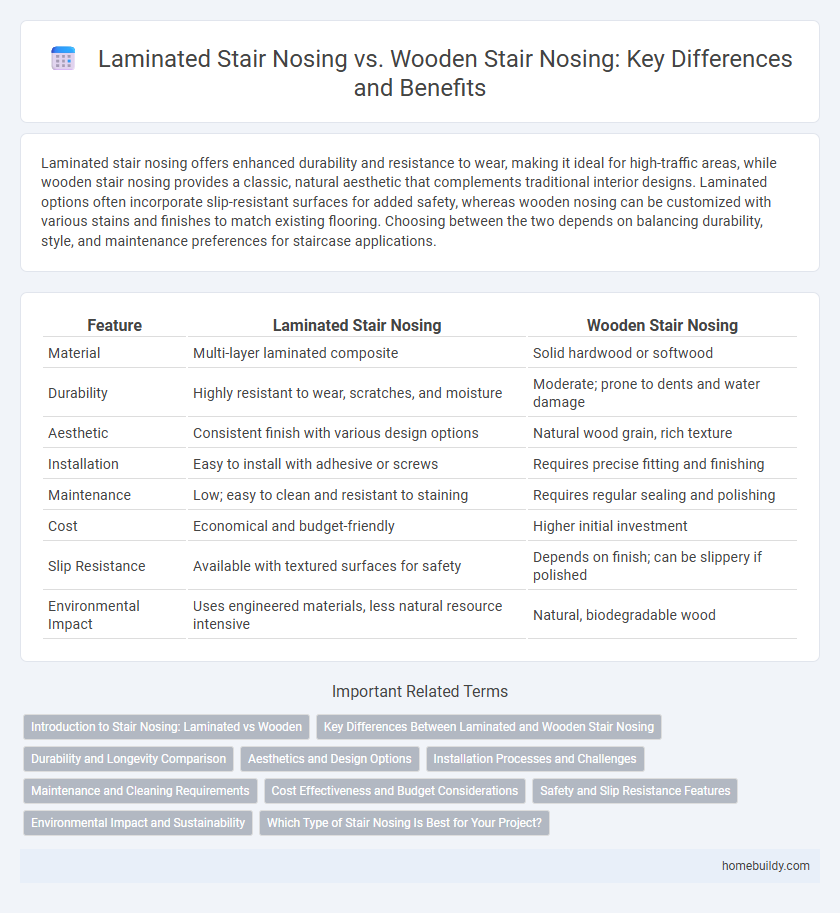Laminated stair nosing offers enhanced durability and resistance to wear, making it ideal for high-traffic areas, while wooden stair nosing provides a classic, natural aesthetic that complements traditional interior designs. Laminated options often incorporate slip-resistant surfaces for added safety, whereas wooden nosing can be customized with various stains and finishes to match existing flooring. Choosing between the two depends on balancing durability, style, and maintenance preferences for staircase applications.
Table of Comparison
| Feature | Laminated Stair Nosing | Wooden Stair Nosing |
|---|---|---|
| Material | Multi-layer laminated composite | Solid hardwood or softwood |
| Durability | Highly resistant to wear, scratches, and moisture | Moderate; prone to dents and water damage |
| Aesthetic | Consistent finish with various design options | Natural wood grain, rich texture |
| Installation | Easy to install with adhesive or screws | Requires precise fitting and finishing |
| Maintenance | Low; easy to clean and resistant to staining | Requires regular sealing and polishing |
| Cost | Economical and budget-friendly | Higher initial investment |
| Slip Resistance | Available with textured surfaces for safety | Depends on finish; can be slippery if polished |
| Environmental Impact | Uses engineered materials, less natural resource intensive | Natural, biodegradable wood |
Introduction to Stair Nosing: Laminated vs Wooden
Laminated stair nosing offers enhanced durability and resistance to wear and moisture due to its composite layers, making it ideal for high-traffic areas and commercial use. Wooden stair nosing provides a natural aesthetic and can be customized with various wood types and finishes, adding warmth and elegance to residential staircases. Both options improve safety by reducing slips and protecting stair edges, but laminated nosing excels in maintenance and longevity while wooden nosing emphasizes style and traditional appeal.
Key Differences Between Laminated and Wooden Stair Nosing
Laminated stair nosing features a durable, multi-layer construction with a protective wear layer that resists scratches, moisture, and heavy foot traffic, making it ideal for high-traffic areas. Wooden stair nosing offers a natural, warm aesthetic with customizable grain patterns but requires regular maintenance to prevent damage from moisture and wear. The primary differences lie in durability, maintenance needs, and appearance, with laminated nosing excelling in longevity and wooden nosing favored for its classic look.
Durability and Longevity Comparison
Laminated stair nosing offers superior durability due to its multi-layer construction, which resists wear, moisture, and impact better than wooden stair nosing. Wooden stair nosing, while aesthetically appealing, is prone to scratches, dents, and warping over time, especially in high-traffic areas or damp environments. The enhanced resilience of laminated materials extends the lifespan of stair nosing by several years, reducing maintenance and replacement costs.
Aesthetics and Design Options
Laminated stair nosing offers a wide range of aesthetic possibilities with customizable patterns, colors, and finishes that can mimic various materials, providing versatile design options for modern interiors. Wooden stair nosing brings natural warmth and timeless elegance with unique grain patterns, but typically offers fewer color variations and requires more maintenance to preserve its appearance. Choosing between laminated and wooden stair nosing depends on the desired look, with laminated options excelling in adaptability and wooden options valued for authentic texture and classic charm.
Installation Processes and Challenges
Laminated stair nosing offers a straightforward installation process due to its pre-finished surfaces and uniform dimensions, reducing the need for extensive on-site adjustments compared to wooden stair nosing. Wooden stair nosing requires precise cutting, sanding, and finishing to match existing stairs, often demanding skilled labor and longer installation times. Challenges with wooden nosing include susceptibility to warping and the need for regular maintenance, whereas laminated options provide more durability and easier installation with fewer tools.
Maintenance and Cleaning Requirements
Laminated stair nosing offers superior resistance to stains and moisture, requiring minimal maintenance and easy cleaning with mild detergents and a damp cloth. Wooden stair nosing demands regular upkeep, including sanding, sealing, and refinishing to prevent damage from moisture and scratches. Selecting laminated options reduces long-term maintenance costs and enhances durability in high-traffic areas.
Cost Effectiveness and Budget Considerations
Laminated stair nosing offers a cost-effective solution with lower material and installation expenses compared to wooden stair nosing, making it ideal for budget-conscious projects. Its durability reduces long-term maintenance costs, while wooden stair nosing, though often more aesthetically pleasing, requires higher upfront investment and potential refinishing expenses. Choosing laminated stair nosing enhances budget efficiency without sacrificing essential safety and functionality.
Safety and Slip Resistance Features
Laminated stair nosing offers enhanced safety through its durable, slip-resistant surface designed to reduce falls and improve traction in high-traffic areas. Wooden stair nosing, while aesthetically pleasing, typically requires additional treatments such as anti-slip coatings or inserts to meet safety standards and prevent slipping hazards. Selecting laminated stair nosing provides superior slip resistance performance, making it ideal for environments demanding stringent safety measures.
Environmental Impact and Sustainability
Laminated stair nosing often incorporates synthetic adhesives and plastic layers, which can hinder biodegradability and increase environmental pollution during disposal. Wooden stair nosing, sourced from sustainably managed forests or reclaimed wood, offers a renewable and biodegradable option with a lower carbon footprint. Choosing wooden stair nosing supports circular economy practices through natural decomposition and the potential for recycling or repurposing wood materials.
Which Type of Stair Nosing Is Best for Your Project?
Laminated stair nosing offers enhanced durability and resistance to wear, making it ideal for high-traffic areas, while wooden stair nosing provides a classic, natural aesthetic that suits traditional interior designs. Laminated options typically require less maintenance and resist moisture better than wooden counterparts, which may be prone to warping or denting over time. Choosing the best stair nosing depends on your project's priorities for durability, appearance, and maintenance needs.
Laminated stair nosing vs wooden stair nosing Infographic

 homebuildy.com
homebuildy.com